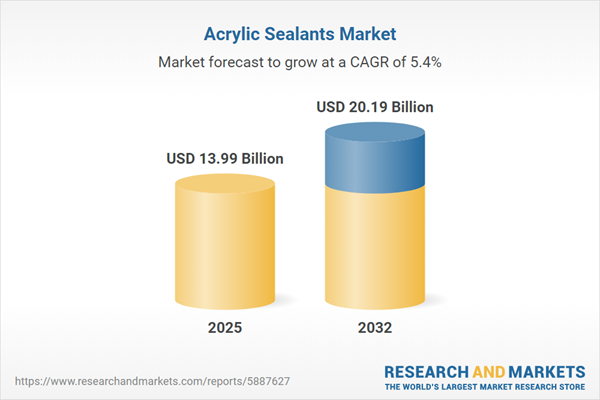Speak directly to the analyst to clarify any post sales queries you may have.
The acrylic sealants market is entering a phase of accelerated transformation, driven by regulatory shifts, technological advancement, and evolving supply chain strategies. Senior decision-makers need clear, actionable insights to inform strategic planning in this dynamic environment.
Market Snapshot: Acrylic Sealants Market Growth and Outlook
The acrylic sealants market grew from USD 13.27 billion in 2024 to USD 13.99 billion in 2025. It is projected to maintain strong momentum at a compound annual growth rate (CAGR) of 5.38%, reaching USD 20.19 billion by 2032. This upward trajectory reflects robust demand across end-user industries, heightened focus on sustainability, and ongoing innovation in formulation technologies.
Scope & Comprehensive Segmentation Analysis
This report delivers a structured analysis of the acrylic sealants market across product innovations, applications, end-user industries, distribution tactics, and regional dynamics. The segmentation covers the following key areas:
- Product Types: Hot Melt (including EVA and Polyamide), Solvent-Based (Acrylic, Polyurethane, Silicone), UV Curable (Epoxy Acrylate, Radcure Acrylate), Water-Based (Acrylic, Polyurethane)
- Applications: Automotive (Aftermarket, Original Equipment Manufacturer), Construction (New Construction, Repair & Maintenance), Electronics (Consumer, Industrial), Packaging (Food, Industrial)
- End-User Industries: Construction (Commercial, Infrastructure, Residential), Electronics (Consumer, Semiconductors, Telecommunications), Industrial Manufacturing (Chemical Processing, Machinery Manufacturing, Metal Fabrication), Packaging (Food, Industrial), Transportation (Aerospace, Automotive, Marine)
- Distribution Channels: Direct Sales (Key Account Sales, Online Sales), Distributors (National, Regional), E-Commerce (Manufacturer Website, Third-Party Platforms)
- Regional Coverage: Americas (North America: United States, Canada, Mexico; Latin America: Brazil, Argentina, Chile, Colombia, Peru), Europe, Middle East & Africa (Europe, Middle East, Africa), Asia-Pacific (China, India, Japan, Australia, South Korea, Indonesia, Thailand, Malaysia, Singapore, Taiwan)
- Key Companies Profiled: Henkel AG & Co. KGaA, Sika AG, 3M Company, H.B. Fuller Company, Dow Inc., RPM International Inc., Arkema S.A., Huntsman Corporation, Wacker Chemie AG, Shin-Etsu Chemical Co., Ltd.
Key Takeaways for Senior Decision-Makers
- The acrylic sealants market is adapting rapidly in response to regulatory requirements demanding reduced emissions and greener formulations. Innovation is driven by hot melt, water-based, and UV curable systems replacing traditional solvent-based solutions.
- End-user industries, including automotive, electronics, and construction, are investing in products that provide superior bonding performance, durability, and compliance with environmental mandates. This aligns with evolving consumer expectations and industry-specific challenges.
- Digital transformation across manufacturing operations is boosting quality monitoring and supply chain optimization. Automation and real-time analytics are enhancing efficiency, supporting rapid scaling, and improving product reliability.
- Collaborative efforts among material scientists, equipment manufacturers, and sustainability leaders are shortening development cycles for advanced sealant formulations and supporting long-term strategic positioning.
- Distribution strategies are shifting, with direct sales, e-commerce, and national distribution channels all expanding reach, enabling access to a diverse portfolio of solutions tailored to specialized industry needs.
Tariff Impact and Supply Chain Adaptation
The introduction of new United States tariffs in 2025 altered material sourcing and supply chain strategies for acrylic sealants. Stakeholders are investing in domestic supply partnerships, accelerating near-shoring, and renegotiating contracts to mitigate cost pressures. Additionally, the industry is increasingly adopting alternative chemistries and integrating advanced analytics to optimize procurement decisions and manage future policy shifts. These adaptations strengthen resilience and prepare businesses for ongoing geopolitical uncertainties.
Research Methodology & Data Integrity
This report is built on robust research methods, including primary interviews with industry experts in polymer science, production engineering, and compliance, alongside secondary data from validated industry sources and publications. Analytical frameworks, such as SWOT analysis and cross-segment modeling, ensure comprehensive, reliable insights tailored for strategic objectives.
Why This Report Matters to Industry Leaders
- Enables informed strategy formulation through in-depth market segmentation and current trend analysis across key industries and regions.
- Supports risk mitigation and opportunity identification by highlighting the impact of regulations, digital innovations, and evolving distribution channels.
- Assists executive teams in capitalizing on growth drivers while navigating supply chain shifts, market entry challenges, and sustainability expectations.
Conclusion
The acrylic sealants market continues to evolve, offering new pathways for innovation and operational efficiency. Leaders who proactively align strategies with these emerging trends can secure a durable competitive advantage and sustainable growth.
Additional Product Information:
- Purchase of this report includes 1 year online access with quarterly updates.
- This report can be updated on request. Please contact our Customer Experience team using the Ask a Question widget on our website.
Table of Contents
3. Executive Summary
4. Market Overview
7. Cumulative Impact of Artificial Intelligence 2025
Companies Mentioned
The companies profiled in this Acrylic Sealants market report include:- Henkel AG & Co. KGaA
- Sika AG
- 3M Company
- H.B. Fuller Company
- Dow Inc.
- RPM International Inc.
- Arkema S.A.
- Huntsman Corporation
- Wacker Chemie AG
- Shin-Etsu Chemical Co., Ltd.
Table Information
| Report Attribute | Details |
|---|---|
| No. of Pages | 199 |
| Published | October 2025 |
| Forecast Period | 2025 - 2032 |
| Estimated Market Value ( USD | $ 13.99 Billion |
| Forecasted Market Value ( USD | $ 20.19 Billion |
| Compound Annual Growth Rate | 5.3% |
| Regions Covered | Global |
| No. of Companies Mentioned | 11 |









